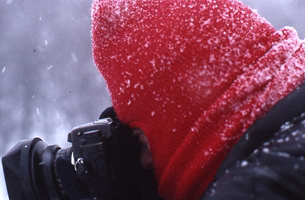Winnie Denker
Webmaster: John Sheehan
|
Winnie Denker
Webmaster: John Sheehan |
 |
 |
 |
English:
Originaly from Denmark, she is one of the few photographers in the world to work with the 20X25 format. Another characteristic of her work, Fresson shots, unic technique carried out with gold pigments, of coal and color, but also of Platinizes and Silver shots. Winnie Denker arrives in Paris in 1958. During nearly 20 years, she is devoted to fashion photograph and the still life, until her ultimate meeting with the Eiffel Tower, at the end of 85. Until then, she is dedicated to architecture and the world cultural inheritance. She also realizes portraits of personalities and famous artists, like the painter De Kooning or Dali.
Flabbergasted by the stereotypes of journalist François Chalais on Vietnam, Winnie Denker decides to start photography in 1965. During three years, she practices in Robert d'Estaing's studio, set in Place Vendôme. Together, they work for the most prestigious couture houses and the greatest creators: Lanvin, Cartier, Chaumet…
1975, New York… Gone for six months, Winnie Denker
will remain 11 years there. There again, she signs contracts for clients as
famous as Vogue, Elle, Cartier, as well as for major international brands. At
the same time, the photographer publishes her first works for "Women's
Wear Daily" and "House and Gardens".
Her first book of reference, " The library of Nation USA ", is published
in 1983 (Ed. Time Life).
At the end of 85, returns to Paris, her fetish city...
Informed by the Eiffel Tower's new lighting, the artist has an immediate crush.
It's the beginning of a long love story, which began on January 4 1986, date
of her first cliché of the iron lady, and which continues today, nearly
20 years later.
From this passion will appear two books: " La sentinelle de Paris ",
in 1989, for the centenary of the Eiffel Tower (éd. Robert Laffont) and
" Paris, fêtes et lumières " (éd. Images-Magie),
in 1993. A third collection of photographs is in process of being done (to be
realeased in October 2004).
At the same time, between 1991 and 1997, the Unesco gives her several missions for the world Inheritance of humanity. The photographer then multiplies journeys throughout the world (Istanbul, Saint-Petersburg, Syria, Cairo, Lebanon) and the reference works, published in several languages: " La Grande Catherine " (éd. Ville de New Orleans) in 1995, " La civilisation de Saint-Pétersbourg " (éd. Mengès) in 2000, "Constantinople" (éd. Mengès) in 2001…
Regularly published in the international press for her work, Winnie Denker in addition exposes her work throughout the whole world: Around twenty exhibitions throughout Spain, but also in Tokyo, Washington, New York, Paris, Florence, without forgetting a permanent exhibition in the Hermitage Museum of Saint-Petersburg.
French:
D'origine danoise, elle est l'une des rares photographes au monde à travailler au format 20X25. Autre particularité de son œuvre, des tirages Fresson, technique unique réalisée avec des pigments d'or, de charbon et couleur, mais aussi des tirages Platine et Argentique. Winnie Denker arrive à Paris en 1958. Pendant près de 20 ans, elle se consacre à la photo de mode et aux nature morte, jusqu'à sa rencontre décisive avec la Tour Eiffel, fin 85. Dés lors, elle se voue à l'architecture et au patrimoine culturel mondial. Elle réalise également des portraits de personnalités et artistes célèbres, comme le peintre De Kooning ou Dali.
Troublée par les clichés du journaliste François Chalais sur le Vietnam, Winnie Denker décide de se lancer dans la photographie en 1965. Durant trois ans, elle fait ses armes dans le studio de Robert d'Estaing, installé Place Vendôme. Ensemble, ils travaillent pour les plus prestigieuses maisons de couture et les plus grands créateurs : Lanvin, Cartier, Chaumet…
1975, New York… Partie pour six mois, Winnie Denker y restera 11 ans. Là encore, elle signe des contrats pour des clients aussi réputés que Vogue, Elle, Cartier, ainsi que pour de grandes marques internationales. Parallèlement, la photographe publie ses premiers ouvrages pour " Women's Wear Daily ", " House and Gardens ". Son premier livre de référence, " The library of Nation USA ", est publié en 1983 (Ed. Time Life).
Fin 85, retour à Paris, sa ville fétiche... Avertie du nouvel éclairage de la Tour Eiffel, l'artiste a immédiatement le coup de foudre. C'est le début d'une longue histoire d'amour, commencée le 4 janvier 1986, date de son premier cliché de la Demoiselle de fer, et qui continue aujourd'hui, soit près de 20 ans plus tard. De cette passion naîtront deux ouvrages : " La sentinelle de Paris ", en 1989, pour le centenaire de la Tour Eiffel (éd. Robert Laffont) et " Paris, fêtes et lumières " (éd. Images-Magie), en 1993. Un troisième recueil de photographies est en cours de fabrication (sortie prévue en octobre 2004).
Parallèlement, entre 1991 et 1997, l'Unesco lui confie plusieurs missions pour le Patrimoine mondial de l'humanité. La photographe multiplie alors les voyages à travers le monde (Istanbul, Saint-Pétersbourg, la Syrie, Le Caire, le Liban) et les ouvrages de référence, publiés en plusieurs langues : " La Grande Catherine " (éd. Ville de New Orleans) en 1995, " La civilisation de Saint-Pétersbourg " (éd. Mengès) en 2000, " Constantinople " (éd. Mengès) en 2001…
Régulièrement publiée dans la presse internationale pour son travail, Winnie Denker expose par ailleurs ses œuvres à travers le monde entier : Une vingtaine d'expositions dans toute l'Espagne, mais aussi à Tokyo, Washington, New York, Paris, Florence, sans oublier une exposition permanente au Musée de l'Ermitage de Saint-Petersbourg.